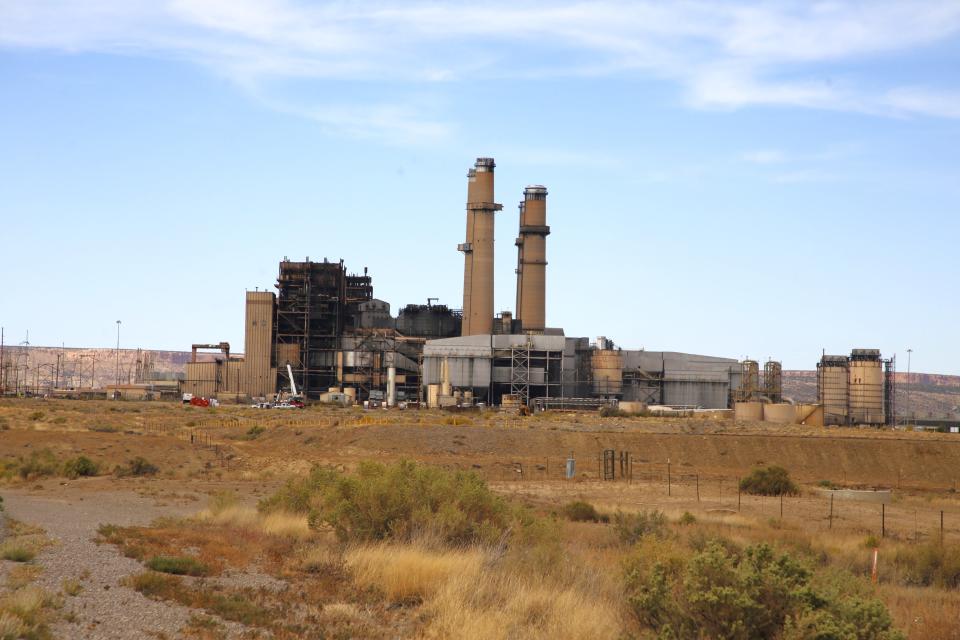Officials say San Juan County has weathered power plant closure well, but concerns linger
When New Mexico lawmakers passed the Energy Transition Act in the late winter of 2019, their action did more than set the state on a path toward greatly increasing its use of renewable energy — it also assured the closure of one of the cornerstones of the San Juan County economy, leading to widespread worries about how the area would survive such a setback.
The ETA’s requirement that New Mexico generate 50% of its energy through renewable sources by the year 2030 meant that the San Juan Generating Station — a coal-fired power plant in Waterflow owned primarily by the Public Service Co. of New Mexico, a long with various other shareholders, such as the city of Farmington — would be shuttered many years before PNM originally had planned to retire it.
That closure came a year ago last week. Over several years, as various elements of the plant were idled, that meant the loss of hundreds of good-paying jobs at the plant and at the accompanying Westmoreland San Juan Mine, which kept the plant supplied with the coal it needed to operate.
When the 2022 closure of the plant was announced in 2019, many local observers predicted it would have a near-catastrophic effect on San Juan County. But with a year now having passed since the facility went dark, it has become increasingly clear that those fears largely were unfounded, as many of the county’s economic indicators are strong, perhaps even robust.

The question is, how did San Juan County avoid that economic doomsday scenario? Government and academic officials who were interviewed for this article credit a number of factors for the county’s relatively soft landing while still emphasizing that the shutdown of the station was far from painless — especially for the hundreds of displaced workers who wound up in the unemployment line or the recent increase in electricity rates for consumers.
“The transition we thought would be pretty rough has been a little smoother than anticipated,” said San Juan County Manager Mike Stark, though he added that the jury remains out on how the county will adapt to the closure over the long term and that some impacts could make themselves more apparent as time passes.
"Ultimately, we need to see how the plane hits the runway," he said.
More: PNM expects demolition of San Juan Generating Station to begin this spring
Everyone helped shoulder the burden as coal plant closed in Waterflow
Lorenzo Reyes, the vice president of workforce development at San Juan College, said he believes that it was those very fears of an economic apocalypse that may have allowed the county to escape the worst effects of the plant’s closure. A community-wide awareness of how challenging the situation would be provided for a quick mobilization of people and resources throughout San Juan County, and beyond, in 2019, he said.

“Just by getting everybody involved, you mitigate the impact of (the closure) considerably,” Reyes said, explaining that he had previously worked in a community that went through a similar experience. “People needed to be aware of the drastic impact if nothing was done. Everybody here worked together to mitigate that impact.”
Reyes said the involvement of key local stakeholders was critical to San Juan County’s response, including representatives of the county’s municipalities, San Juan County officials, Navajo Nation officials, San Juan College officials, Four Corners Economic Development officials and representatives of the business community.
The local effort was bolstered in no small part by the involvement of state officials through the provisions of the ETA, which mandated that each displaced worker from the plant and the mine, as well as their contractors, would be entitled to a one-time, taxable $20,000 payment from the state. That program is being administered by the New Mexico Department of Workforce Solutions.
Stacy Johnston, the communications and marketing director for the agency, said as of Sept. 29, 487 applications from displaced workers had been approved by state officials, and 445 checks had been delivered since May 23. That resulted in a total expenditure of approximately $9 million, she said. Most of that money wound up in San Juan County, as 96% of the displaced workers still reside here, Johnston said.
More: San Juan County sees infusion of money from ETA payouts to displaced workers
Sarita Nair, the New Mexico secretary of workforce solutions, said during a May 2 kickoff event for the check-application process at McGee Park that she expected between 400 and 600 displaced workers to apply for the funds, and that forecast has proven to be on the mark. Johnston said additional checks will continue to be distributed through October.
Reyes said those funds did more than provide temporary relief to displaced workers. They also provided a significant boost to the retail sector, as much of that money likely has been spent on items large and small throughout San Juan County, he said, helping those businesses and inflating the gross tax receipts upon which local governments rely.
Stark said those $20,000 payments were helpful. But he noted they were only short-term stimulus, and the impact of those payments will decline as time goes by.
Perhaps more important, he said, are other provisions of the ETA that provide job training to those displaced workers, allowing them to re-enter the workforce in other positions. Johnston said the Department of Workforce Solutions created a “bridge program” that was designed to serve those workers between the time they were laid off and the next step in their career path. She said more than two dozen workers have started training using federal Workforce Innovation and Opportunity Act funding.
The next steps for the Department of Workforce Solutions, she said, are to develop a proposal for additional uses of ETA funds and hold an ETA Community Advisory Committee meeting.
Other factors worked in favor of San Juan County following coal plant closure
Warren Unsicker, the economic development director for the city of Farmington, said he believes that some of those laid-off workers may have benefited from some fortuitous timing. He said the oil and gas industry experienced a boom just as the plant closed, and some of those workers may have been able to land new but similar jobs in that field just as their employment at the plant or the mine was ending.
Unsicker also said many of the displaced workers were old enough to retire, alleviating the impact of those layoffs on the local unemployment rate. Johnston cited figures confirming that assertion, indicating that 26% of those displaced workers have, in fact, retired.
Another factor that contributed to the soft landing, Unsicker said, was the gradual shutdown of the plant and the mine, which meant the impacts of the closure were spread out over a period of several years, as opposed to all at once.
Stark, the San Juan County manager, agreed with that assessment.

“That was helpful, no doubt about it,” Stark said. “Obviously, the Energy Transition Act was not something our county was in favor of. But we do appreciate that there was advance notice and that it provided funding to displaced workers.”
That years-long runway gave the county time to prepare for the significant change that was headed its way. By the time the plant’s closure was announced in 2019, government officials throughout San Juan County already had begun to make a concerted effort to diversify the local economy by emphasizing outdoor recreation opportunities in hopes of generating more tourism and hospitality spending.
But as the closure date neared, those efforts seemed to take on an increased sense of urgency, and a significant number of additions to the county’s inventory of outdoor attractions was made or planned. Part of that is being achieved with millions of dollars in lawsuit settlement money the state received from the U.S. Environmental Protection Agency for its role in the disastrous 2015 Gold King Mine spill. But other projects are being funded by a variety of other grant or bond sources, or foundation funding.
More: Regional planners look for the next step as environmental activists laud SJGS demise
“A lot of that was low-hanging fruit,” Unsicker said. “We’ve got all those beautiful, amazing things to do and places to go. We just needed to capitalize on it.”
Over the next few years alone, the county will see the addition of a major new mountain biking park at San Juan College, the construction of a standing wave on the Animas River suitable for surfing, hundreds of miles of new hiking, biking and four-wheeling trails, the opening of a next-generation all-abilities park in Farmington, new boat ramps on the San Juan and Animas rivers, and other attractions. All of those projects — coming at a cumulative price tag of tens of millions of dollars — are designed to enhance the county’s standing as a premier outdoor recreation destination.
“It had to have an impact,” Reyes said of the plant’s closure on the increased emphasis on the development of outdoor attractions. “But I’m not sure to what extent. … Those efforts have kind of been running parallel to (efforts to keep the plant open) for many years.”
Still, as the reliance on fossil fuels industries begins to wane worldwide, Reyes said a growing awareness of that decline has led many folks in San Juan County to look elsewhere for answers.
“That got a lot of people thinking, ‘What is the next thing to do? How do we promote the area?’” he said.
For several years, San Juan County has tried to position itself on the leading edge of that curve, he said. While other local entities are focused on developing new outdoor recreation opportunities, the college is trying to help entrepreneurs interested in manufacturing outdoor recreation products.
“That’s where we can have a significant impact on our outdoor recreation economy,” Reyes said.
More: Several indicators reveal strength of San Juan County economy, local officials say
The college is actively reaching out to those entrepreneurs, he said, and has received significant state and federal funding to support their efforts and provide them with training at its Enterprise Center, part of the San Juan College Quality Center for Business. The idea, he said, is to be able to walk alongside those new business owners from the time their product is merely a concept to when it rolls off the assembly line and is shipped to a purchaser.
Stark said other industries throughout the county have helped fill the void left by the closure of the station, noting that two new solar projects will help supply the electricity that no longer is being generated at the plant. There has been a strong uptick in retail construction in recent years, he said, and the county is playing a major role in a hydrogen hub project that could turn into a significant economic multiplier.
Finally, work continues on a collaboration between county officials, the Navajo Nation and other entities to build a railroad spur between Interstate 40 and San Juan County that would greatly enhance the county’s attractiveness as a manufacturing center, he said.
'How do we fix this?'
Perhaps the most profound lesson to emerge from the closing of the San Juan Generating Station relates to Reyes’ contention that folks throughout San Juan County didn’t simply sit on their hands and despair when the ETA was passed in 2019.
“All the key stakeholders in the community continued to work together,” he said, noting there was a strong effort made to identify the county’s assets and determine how to leverage them to everyone’s advantage.
“None of us could have foreseen exactly how this would have played out,” Unsicker said of the closure and its aftermath.
More: San Juan Generating Station cleanup would have state oversight, if New Mexico bill passes
But over the past four years, there has been a concerted effort to move San Juan County past the ebbs and flows of an energy-based economy to one that is more stable, reliable and sustainable. That has required, and received, buy-in from everyone, he said.
“We all work well together up here,” Stark said.
“Whether you’re talking about the cities, the county, the Navajo Nation, San Juan College or the state of New Mexico, we all work together to find solutions to problems. We’re a pretty resilient community. If there’s an issue or a problem, it’s not ‘Woe is me,’ it’s ‘How do we fix this?’ That’s something that’s been strengthened through this experience.”
Mike Easterling can be reached at 505-564-4610 or measterling@daily-times.com. Support local journalism with a digital subscription: http://bit.ly/2I6TU0e.
This article originally appeared on Farmington Daily Times: Economy a concern 1 year after power plant closure in San Juan County

